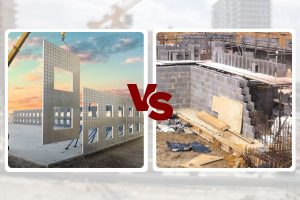

“Just like assembling a giant LEGO set, prefab modular construction, prefab homes are constructed in factories, piece by piece. Instead of building everything brick by brick on-site,. These pieces are transported to the building site and brought together like puzzle pieces, property development and construction expert David Baynie explains.
Prefabricated buildings are growing in popularity with no sign of slowing down. Infact, the government of Australia provides a $28million CRC grant in prefabricated buildings to transform the Design & Production of Buildings in Australia. 30 industry partners, government and research partners received the grants plus combined $103 million as a collaborative initiative to reduce waste, emissions and delays as companies deliver better buildings that are more efficient, cheaper to build and safer, David Baynie further explains.
Traditional construction has been around for ages, especially during days of woods and stones and it evolves as new materials and better methods were introduced. It is like building a house from scratch, one brick at a time. The entire process takes place on the building site, from laying the foundation to painting the walls.
So, which method is better? Well, it depends. That is why David Baynie looks into prefab and traditional construction, exploring the pros and cons to help you make informed decisions, perfect for your needs and preferences.
Prefab
Prefab homes are houses that are built in a factory and then transported to the building site to be assembled. It is not like traditional construction, where the entire building process takes place on-site.
The individual buildings are partially or totally constructed offsite, each piece being brought together to the final location where it is installed quickly and efficiently. This method can often be faster, more cost-effective, and more environmentally friendly than traditional construction.
As explained earlier, traditional construction are homes that are built from start to finish on site, specifically where the occupants will reside. All construction materials are sent to the location and constructed at the same place.
Prefab and traditional construction methods offer different advantages and disadvantages. Here’s a breakdown:
Speed: nothing beats having your building up and running in a fraction of the time. Since prefab components are built off-site and assembled on-site, the construction timeline is significantly shorter—think weeks instead of months!
Efficiency: Since prefab components are manufactured in controlled environments, the chances of errors or weather delays are lower. This boosts overall consistency and quality.
Cost-effectiveness: Who doesn’t love saving money? Prefab methods are often more budget-friendly due to streamlined production, fewer labor hours on-site, and less material waste.
Environmental friendliness: Factory production can minimize on-site construction activities, reduce waste, make use of sustainable materials while reducing environmental impact. This is why it is more preferred to traditional buildings.
Limited customization: Prefab homes or buildings can sometimes feel like “one-size-fits-all.” The flexibility it offers is less as compared to traditional construction that allows more design and customization.
Transportation costs: Transporting prefab modules to the building site can add to the overall cost and transporting larger structures can be challenging.
Perception: Some buyers or tenants may have preconceived notions that prefab buildings are “cheap” or less durable, even though modern prefab designs can sometimes beat traditional construction to the game.
Permits and regulations: David Baynie says that obtaining permits and approvals for prefab construction can sometimes be challenging as it often requires a lot of paperworks and permits.
Customization: Traditional construction allows for almost unlimited design possibilities. Every wall, window, and detail can be tailored to fit your vision.
On-site adjustment and monitoring: If you’re the type to make decisions on the go, traditional construction offers flexibility. Changes can be made as the project unfolds. Plus, builders can closely monitor the construction process throughout.
Local materials: Traditional methods often use locally sourced materials.
Familiarity: There’s a comfort in the known. Many are familiar with the traditional methods, hence, then tend to believe more in its long-standing reliability and solidity.
Time-consuming: Time is money, and traditional construction typically takes longer to complete. You’re at the mercy of weather delays, availability of workers, and slower construction methods.
Higher Costs: Customization and on-site labor come at a higher price tag. Traditional builds are generally more expensive due to longer timelines and higher labor and material costs.
Environmental Impact: Traditional methods usually involve more waste and use more resources, making it less eco-friendly compared to prefab.
David Baynie says the choice between prefab and traditional construction depends on your specific needs and preferences but here are some factors to consider when making your decision:
It’s often helpful to consult with both prefab and traditional builders to get a better understanding of their processes, costs, and the benefits they can offer. They can also provide you with references and examples of their work.
Beautiful hand-drawn animation, fascinating environments, and cozy storytelling abound at Studio Ghibli. You are on…
Renowned for their vibrant food scene, low prices, and enticing tastes, Chinatown hawker centres are…
The Indian Premier League (IPL) is one of the world's biggest cricket leagues, famous for…
There are a lot of websites on the internet that provide a range of services;…
For decades, city-building simulators have captivated the gaming community, but "SinpCity" represents the next frontiers…
Situated at the heart of West Bengal, Rampurhat is a town with a tropical climate…